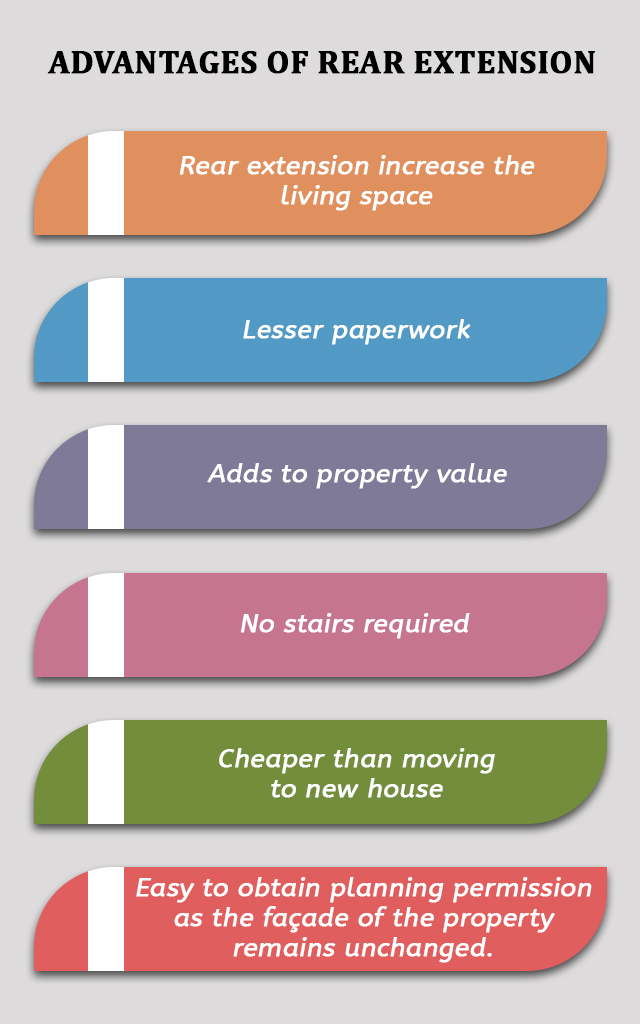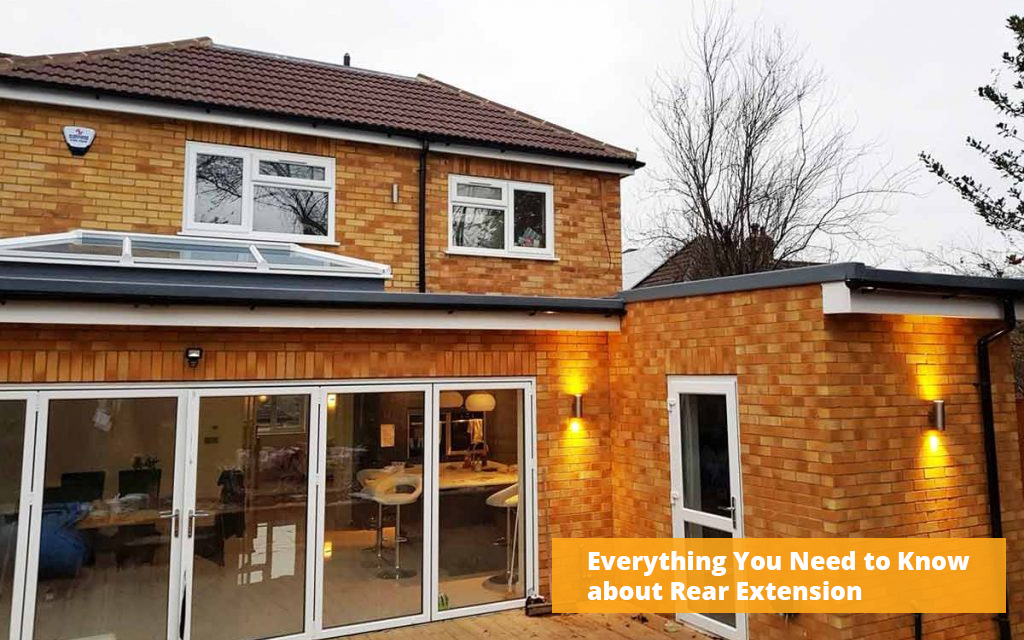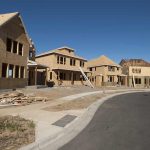Rear extensions dramatically increase the space and value of your home. Here’s everything you need to know about modern rear extension, ideas, types, planning permissions, costs and other things to keep in mind before kick-starting your project.
Want to go for a makeover of your clumsy kitchen to make it look trendy and more spacious?
Rear extension is a perfect way to get that extra space you have been longing to expand your kitchen, living, dining or other socializing areas.
Going for this type of extension not only helps you fulfil your space constraints but also adds to the value significantly.
Keep reading to discover some amazing rear extension ideas, everything about their types, costs, planning permission and how it can be created on terraced, semi-detached or detached properties.
What is a rear extension?

A rear extension extends from the end of your home into the garden space. This helps you gain additional area to expand your kitchen, dining and living space.
Mostly the modern rear extension is created along the width of the property and extends 3-6m towards the rear. They either have a pitched roof or flat roof.
Advantages of rear extension
- Rear extension increase the living space
- Adds to property value
- No stairs required
- Lesser paperwork
- Cheaper than moving to new house
- Easy to obtain planning permission as the façade of the property remains unchanged.
When it comes to rear extension ideas, there are actually two possibilities.
- Rear extension can be used to expand the size of the existing space such as the kitchen or dining area.
- New space can be created such as new room, bathroom, study room etc.
What are some modern rear extension types?
Planning to give your housing property a new attire with a modern rear extension? Have a look at some inspiring rear extension ideas that you can explore.
1. Rear extension on a terraced house
If you’re planning to give a new look to your terraced house so that both space and light can be maximized, rear house extension should be your choice.
This rear extension idea is both internally effective as well as externally tempting for your house. This type of rear extension comes with skylights and sliding doors.
Hence, all parts of your home can witness natural light.
The walls are also white painted under this type of rear extension, making room for natural light to bounce around the house.
The ceiling of this type of a house is in vaulted form and this structure also contributes to the light maximization.
2. Rear extension on a detached house
Going for rear extensions to a detached home are the easiest one if the home doesn’t fall in a conservation area or is a listed building.
The best part of rear extensions in the detached home is that it will never run into any sort of problems with neighbours.
Also, it’s easy to get approval from planning permission or permitted development rights.
3. Rear extension to a Listed Building
You need to get official approval from the Planning Permission as adding a rear extension to a listed building doesn’t come under the permitted development rights.
It’s difficult to get permission as these buildings are very beautiful and need to be preserved.
You need to convince the authorities that the new construction will help protects and preserve the original structure, you may get the approval.
Or, else proving that the original structure had a rear extension might help in speeding the approval for rear extension.
For, all other reasons there might be a chance that the application is turned down and either require you to change your design.
4. Rear extension to a Conservation Area
Similar to adding rear extension to listed building, you need to take planning permission to go for any rear and side extension to a conservation area.
You can contact local authorities regarding the local architecture features or the other do’s and don’ts to be followed for the new planned extension.
Read More:- What Building Regulation Do I Need for A Home Extension
5. Flat roofed bungalow rear extension
If you’re planning on bungalow rear extension, this type of rear extension can be a proper fit. A bungalow with rear extension can give a contemporary turnout to your property.
It is indeed the best option that helps to add more amenities and facilities to the bungalow because they are built on large plots, and you’ve enough space for a rear extension.
6. Crittall style rear extension or Glass Rear Extension
You must already know about the rising popularity of Crittall style doors in the UK.
Crittall style doors and windows can give your property an instant touch of style and also add the desired glamour and elegance to the space.
So, try to merge your glass rear extension ideas with Crittall style doors and windows and see the magic. These doors also look good from the inside and make your interiors look newer.
Reach out to the best house rear extension experts in UK for modern Crittall doors that are double glazed, fire-rated and are thermally super-efficient.
7. Single storey rear extension
Single storey helps you get some excess space (and value) on the ground floor of your existing property.
The best thing about single storey rear extension is that the backside of your home gets opened and you can use this excess space for gardening purposes.
From extra bedroom to studies, this single storey rear extension can be converted into anything you want it to be and helps you make your home perfect!
8. Double storey rear extension or 2 Storey rear extension
Double storey rear extension is pretty common in the UK and it also gives your property a contemporary touch.
Commonly known as 2 storey rear extension, it’s adding an extension and a floor above it to the rear of the property.
It may happen that you have an existing single storey rear extension and still need more space. Going for 2 Storey rear extensions would give you the space you dream and desire.
It is indeed a great option to add another bedroom upstairs that opens up a great space for a spacious kitchen, living room or anything else that you may want to.
Do you need planning permission for rear extension plans?
There’s no fixed answer to this question. Many councils based in the UK consider rear extension as a part of Permitted Development (PD).
If your planned layout of rear extension falls under those councils and it satisfies all the PD rules and regulations, then you don’t need any permission.
However, if your property plan does not fit with PD guidelines, you have to apply for an approval.
Even though you can apply it yourself, it may not always work. Largely because you need proper drawings of your rear extension plan and for that, it is better to seek expert assistance.
Here are some cases when you need to seek planning permission for a rear extension.
- If your house falls under a listed building or in a conservation area, you may need to apply for approval from planning permission.
- The size of planned rear extension is more than half the width of the property.
- All the single storey rear extension cannot be more than 4m in height.
- The new roof of the rear extension should not be higher than the existing roof.
- The proposed extension should be taller than 3m and should fall within 2m of the property boundary.
- You may need to seek permission in case the rear extension includes chimneys, balcony, verandas or microwave antenna.
- Any alteration to the original roof.
- Usage of any material to be used on the exteriors other than the existing one would require seeking permission.
Building Regulation for rear extension plans
Approval from Building Regulations for rear extensions is required irrespective of location and size.
The drawings for the rear extension layout that are to be submitted for approval to building regulation authorities should include details on:
- Sound insulation
- Fire safety
- Detailed structure layout
- Drainage electrical design/installation
- Mechanical design/installation
- Ventilation
How to Build a Rear Extension?
After getting the planning permissions as well as the approval from building regulations, the construction for rear extension can be stated as per the approved drawings.
Step1: Preparing the site
Before the work begins, it’s important that neighbours are well informed about the constriction so as to avoid any hassles, complaints or denial of access.
Also, proper arrangements should be made to ensure that site access is clear and there is proper space to store the building material.
Step2: Drainage and Groundworks
The ground is then excavated for foundations and pouring the concrete followed by piping, wiring, drainage and other services.
The building control inspector should be contacted to approve the foundations.
Step3: Building
The actual building process starts now that involved digging of trenches, working on extension of walls, concrete flooring and measuring dimensions for doors and windows.
Fitting and installation of downpipes and connecting them to the drainage system.
Step4: Remodelling
After the structure is complete, all the redundant fittings and internal fixtures are removed. The internal space is reconfigured as per the requirements.
Step5: Finishing touches
Now, it’s time to go for electrical and plumbing works as per the requirement and nature of the rear kitchen extension.
Final decorations, appliance set up and other interior set up can be done.
How much does a rear extension cost?
There is no fixed cost of rear extension. You need to understand first about your necessities and then only the cost can be estimated.
The rear extension cost depends on a lot of factors including labour cost, materials and other application costs of planning permission.
High-quality materials are expensive but are worth if you want your rear extension to look aesthetically appealing and last long. Indeed they come with a good price tag.
But these do increase the value of your home and are worth the investment.
How long it would take to build a rear extension?
Generally, for a single storey rear extension or small rear extension it takes around three to six months for complete construction.
But, it depends purely on the complexity of the project and layouts.
If there are certain other things such as planning permission approval if the building falls in conservation area or is listed, some more time may be accounted.
TEL Constructions: One-stop Company for all your Rear Extension needs
Are you looking for a construction company that can provide you best ideas relevant to a rear extension?
Reach out to TEL Constructions.
With more than 10 years of experience in the construction industry and a dedicated focus on your needs, we have all the in-house talent, tools, machinery, and equipment required to convert your vision into reality.
Our competent team ensures best rear extension designs that are unique and designed completely as per your needs, budget and style.
Planning a rear extension? Get in touch with us at 02081584006 today!
 27 October 2025
27 October 2025 27 October 2025
27 October 2025 27 October 2025
27 October 2025 27 October 2025
27 October 2025 27 October 2025
27 October 2025




mangat